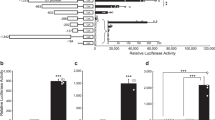Summary
The ability of insect hemolymph to induce vesicles in a high passage insect cell line, IAL-TND1, is described. The factor responsible, designated VPA for ‘vesicle-promoting activity’, was determined to be heat sensitive, nondialyzable, and protease Type XIV sensitive but insensitive to trypsin digestion. In efforts to determine the source of VPA, hemolymph was collected from different developmental stages ofTrichoplusia ni, and certain tissues fromT. ni were cocultured with IAL-TND1 cells. Hemolymph from every developmental stage tested exhibited VPA although the effect was somewhat reduced in spinning-stage larvae. Additionally, several tissue, including fat body, tess, and imaginal discs, released VPA into the culture medium. Neural tissues and endocrine glands did not induce vesicle formation.
Similar content being viewed by others
References
Birek, C.; Aubin, J. E.; Bhargava, U.; Brunette, D. M.; Melcher, A. H. Dome formation by oral epithelial in vitro. In Vitro 18: 382–392; 1982.
Goodwin, R. H.; Adams, J. R. Nutrient factors influencing viral replication in serum-free insect cell line culture. Kurstak, E.; Maramorosch, K.; Dubendorfer, A., eds. Invertebrate systems in vitro. Amsterdam: Elsevier/North Holland Biomedical Press; 1980: 493–509.
Grace, T. D. C. Establishment of four strains of cells from insect tissue grownin vitro. Nature 195: 788–789; 1962.
Lever, J. E. Regulation of dome formation in differentiated epithelial cell cultures. J. Supramol. Struct. 12: 259–272; 1979.
Lynn, D. E.; Oberlander, H. The establishement of cell lines from imaginal wing discs ofSpodoptera frugiperda andPlodia interpunctella. J. Insect Physiol. 29: 591–596; 1983.
Lynn, D. E.; Oberlander, H. Obtainment of hormonally sensitive cell lines derived from imaginal discs of Lepidoptera species. Kurstak, E. ed. Techniques in Cell Biology, vol. 2, Amsterdam: Elsevier Biomedical Press; 1985.
Lynn, D. E.; Miller, S. G.; Oberlander, H. Development of a cell line from lepidopteran wing imaginal discs: Induction of newly synthesized proteins by 20-hydroxyecdysone. Proc. Natl. Acad. Sci. USA 79: 2589–2593; 1982.
Mauchamp, J.; Margotat, A.; Chambard, M.; Charrier, B.; Michel-Bechet, M. Polarity of three-dimensional structures derived from isolated hog thyroid cells in primary culture. Cell Tissue Res. 204: 417–430; 1979.
Rizzino, A.; Gonda, M. A.; Rapp, U. R. Dome formation by a retrovirus-induced lung adenocarcinoma cell line. Cancer Res. 42: 1881–1887; 1982.
Waymouth, C.; Ham, R. G.; Chapple, P. J. The growth requirements of vertebrate cells in vitro. Cambridge, England: Cambridge University Press; 1981.
Yunker, C. E.; Vaughn, J. L.; Cory, J. Adaptation of an insect cell line (Grace's Antheraea cells) to medium free of insect haemolymph. Science 155: 1565–1566; 1967.
Author information
Authors and Affiliations
Rights and permissions
About this article
Cite this article
Lynn, D.E., Oberlander, H. & Ferkovich, S.M. Induction of vesicle formation in a cell line derived from imaginal discs. In Vitro Cell Dev Biol 21, 277–281 (1985). https://doi.org/10.1007/BF02620942
Received:
Accepted:
Issue Date:
DOI: https://doi.org/10.1007/BF02620942



